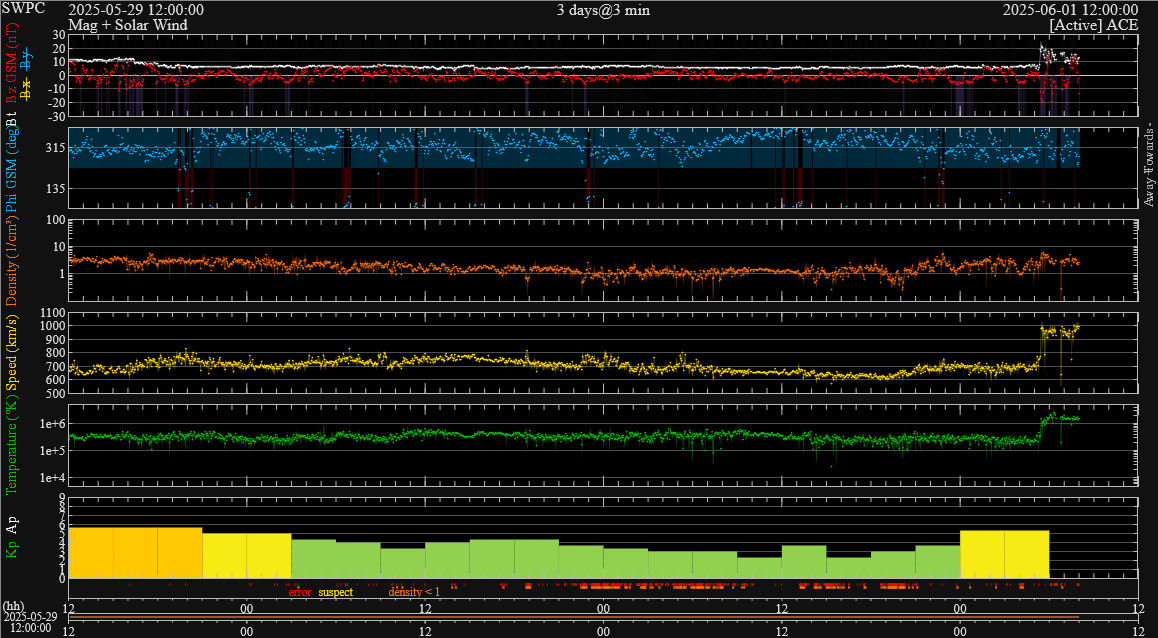UPDATED - For older posts, please scroll down
UPDATE 1 June 2025 at 08:30UTC - What seems to be the interplanetary coronal mass ejection (ICME) associated with yesterday's M8 flare (see post underneath) has apparently already arrived after only 29 hours. A strong shock was indeed registered by DSCOVR at 05:27UTC (chart underneath), with significant jumps observed in solar wind speed (yellow curve), temperature (green) and magnetic field strength (white). It is less obvious in solar wind density (orange), most likely because the earth environment was still under the influence of a coronal hole high-speed low density wind stream. Nonetheless, the solar wind speed jumped from 770 km/s to 970 km/s, and is currently still very close to 1000 km/s. That's an unusual high speed near the earth environment. Bz (red curve) has made a few excursions to -20nT, but clearly we're still not in the core of the ICME.
Geomagnetic conditions are currently already at strong to severe levels (GFZ/Potsdam preliminary Kp of 7+; NOAA estimated Kp of 8). Pending the further evolution of Bz, in particular when it becomes deeply negative for a long period of time (several hours), this geomagnetic storm may even further intensify. Pending the duration of the storm, polar lights may still be visible/photographed from Belgium around midnight.
The greater than 10 MeV proton flux has reached moderate levels, with a maximum of 317 at 07:30UTC on 1 June (GOES).

Original 31 May 2025 at 18:24UTC - Since yesterday, 30 May, the large main sunspot of NOAA 4100 (SIDC Sunspot Group 469) is falling apart. The magnetic restructuring causes interaction with small, peripheral sunspots when they have an opposite magnetic polarity. Several M-class flares have been the result, at different locations around the main spot. The strongest event was a long duration (2 hours!) M8.1 flare peaking at 00:05UTC on 31 May (GOES). The imagery underneath shows the M-class flare in extreme ultraviolet. First at temperatures of 1.2 million degrees (SDO/AIA 193), with the dark elongated structures coronal holes. The flare can be seen as well as some coronal dimming and the interaction of a coronal wave with the coronal holes. Next is a comparison of the M8 flare in AIA 1600 -which shows well the flare ribbon location with respect to the main spots of NOAA 4100- with GOES/SUVI 171 which shows the post-flare coronal loops over the blast area.


A minor solar radiation storm ("proton event") ensued (GOES), but the flux of very energetic proton (100 MeV or more) remained mostly at background levels, so no strong impacts on e.g. satellites or for astronauts are expected. However, the eruption was also associated with a fast, earth-directed CME (see the SOHO/LASCO C3 imagery underneath). From the SIDC space weather forecaster's PRESTO message earlier today: "A halo coronal mass ejection (CME) was first detected in SOHO/LASCO-C2 images from 01:36UTC on May 31. This CME was associated with a long duration M8.1 flare peaking on May 31 at 00:05 UTC, which was produced by SIDC Sunspot Group 469 (NOAA Active Region 4100). This event was associated with a Type II radio emission. The CME has an estimated speed of over 1300 km/s and is expected to be Earth directed. Analysis is ongoing for an estimated arrival time but initial analysis suggests this could arrive at Earth from late on June 1. ... The CME first detected at 07:12 UTC May 30 is also expected to have a glancing blow at Earth on June 2 but may be caught up by today's much faster halo CME."
From the CME's speed, the duration of the flaring event, and the possible CME cannibalism, one may expect that the associated geomagnetic disturbance can reach strong to severe levels, i.e. Kp = 7 or 8, depending of course on the orientation, intensity and duration of Bz. Pending the time of arrival, aurora (polar light) may be photographed from Belgium, and even visible low above the northern horizon. It should be noted that this storm is thought to be much weaker than last year's extreme 10-11 May storm. Further updates can be followed on the SIDC website.






